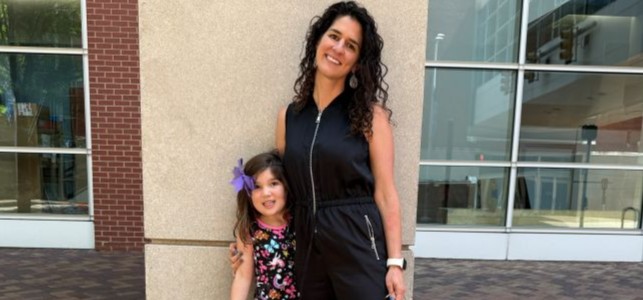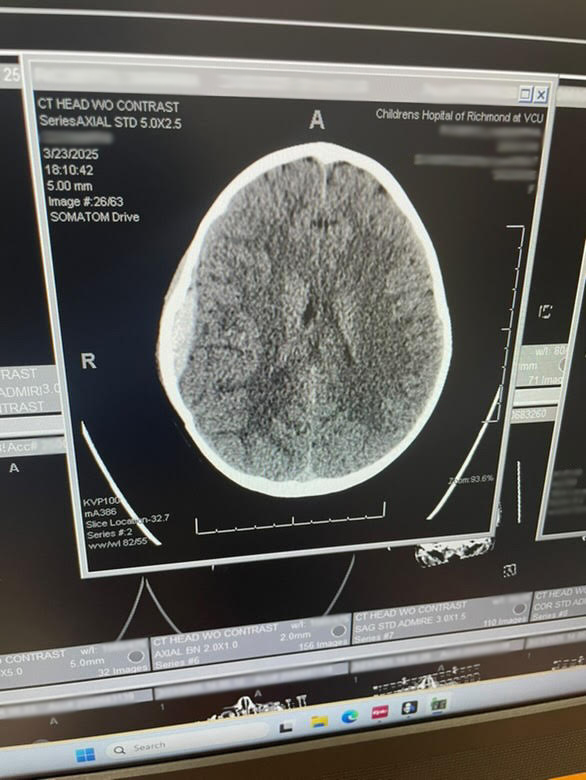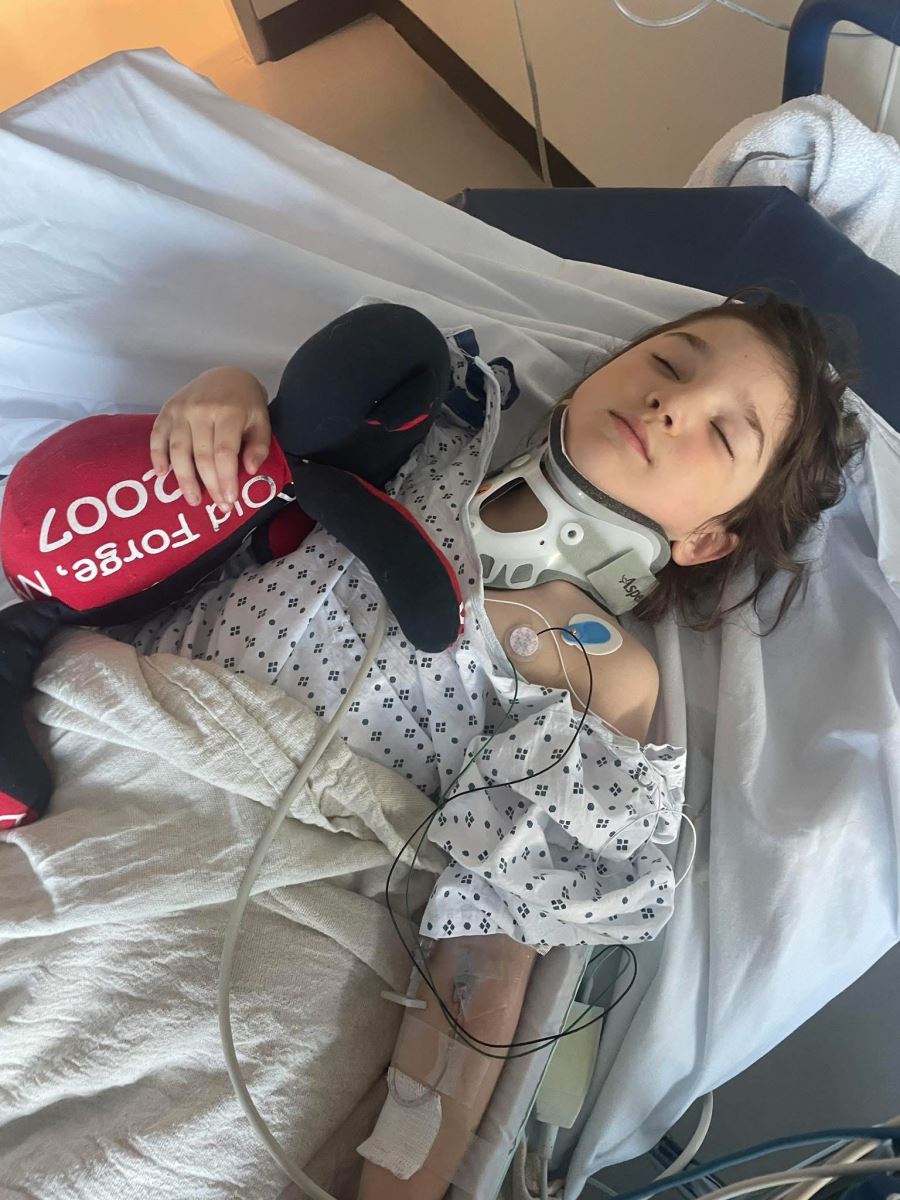
After being airlifted to CHoR for care, Nina Roberts is back in action… with a new helmet.
Many parents know that getting their child to wear a bicycle helmet or helmet for any wheeled sport is about as easy as getting them to put on a winter coat, but the risks involved with not wearing a helmet are just too high.
Richmond mom Kristin Roberts learned firsthand, not only how important it is for a child to wear a helmet, but how important it is that it fits properly. Her 5-year-old daughter, Nina, was wearing one when she crashed her non-motorized scooter and suffered serious injuries, but the helmet was a hand-me-down and wasn’t fitted for her daughter.
“She was on her scooter, and she did not want to wear a helmet for a scooter, but I insisted,” Roberts explained. “She was going just right in front of our house on our street and fell, collided with another kid and fell, with the helmet on and she was still in and out of consciousness.”
Nina was rushed to the nearest hospital, then had to be airlifted to CHoR for treatment of a traumatic brain injury. “The neurosurgeon was saying if she hadn’t been wearing a helmet, it would have been way worse obviously. She would have probably needed surgery,” said Roberts.
Nina was diagnosed with an epidural hematoma, a condition where blood collects between the skull and the brain causing pressure that could lead to brain damage.
Roberts said, “There was no blood, no cut, nothing, but she was laying down and barely able to lift her head.” She knew something was very wrong when her daughter started vomiting almost immediately.
Long-lasting impact of bicycle-related head injuries
CHoR neurosurgery nurse practitioner Michele Ellet helped treat Nina and explained, “I think families underestimate how significant a fall from a bike or scooter can be without a helmet. We rarely see kids with significant head injuries from a bike or scooter fall who were wearing a properly fitting helmet.”
Ellett said there are a variety of very serious conditions that have long-lasting effects that can result from a crash. “We can see a variety of injuries from concussions, skull fractures to life-threatening injuries such as a subdural or epidural hematoma, which may require surgery.”
Even without surgery, treatment and recovery can take longer than you think. “Following a head injury, patients may spend anywhere from 24 hours to several days or weeks in the hospital,” Ellett said. “Some require inpatient rehabilitation prior to going home and typically, kids will be out of school for two weeks.”
As for long-lasting effects, Ellett said, “We often seen patients struggling with headaches, nausea, fatigue, irritability and dizziness as they recover. Physical or occupational therapy is frequently needed to help the patient to get back to their baseline.”
Roberts had been shopping for helmets just two days before the accident, but figured a helmet she had at home would be sufficient. She spoke with Shawn Tevendale, an avid cyclist and owner of Blue Ridge Cyclery, who also worked as a paramedic for 12 years after training at VCU Health.
Tevendale said, “There’s just a lot of technology out there that’s really come forward for head injury prevention or reduction of the severity of the head injury if it occurs.”
But what Tevendale is worried most about is a trend in children’s helmets that he thinks could impact the effectiveness of the protection. He believes unicorn horns, spikes or mohawk decorations may keep the helmets from absorbing the impact. Tevendale explained, “From what I understand from helmet experts in the industry, these items are not being certified for safety with these accessories. These accessories are something that are going on after the fact.”
Tevendale’s biggest concern about those helmet decorations is what happens during a crash. “These items don’t break away in the event of an impact,” he said. “They either create a pressure point if you land on them on the helmet, or they don’t allow that helmet shell to slide the way it otherwise would across pavement, grass or wherever the crash occurs.” While he said no study has been done specifically on the safety of those types of helmets, he added, “They also clearly don’t comply with the standards of the rest of the industry.” But Tevendale does admit novelty helmets encourage children to wear head protection which is a step in the right direction.
According to a study by the National Institutes of Health, bicycle crashes are a leading cause of traumatic brain injuries in children. Each year, there are an average of 140,000 head injuries among kids and teens in the U.S. and nearly 250 deaths.
The same study says properly fitting helmets can reduce the risk of head injury and TBI as much as 88%. That equates to 116,000 head injuries and 184 deaths.
Getting the proper fit
So how do you know you have the right fit? Here are two rules of thumb: If the helmet slides too far forward, the back of the head is vulnerable, and if it slides too far back, the forehead may not be protected.
Corri Miller-Hobbs with Safe Kids Virginia, has these tips:
- Different helmets are made for different sports. For safety during any wheeled sport, make sure your child wears a helmet with a label that indicates it was specifically made for that sport and meets the standards of the Consumer Product Safety Commission.
- Make sure the helmet doesn’t move when your child’s head moves. It should be snug enough to move the skin on the forehead, but not too tight.
- The helmet should sit low on the forehead, about two finger-widths above the eyebrows.
- Ear straps should be snug and form a “V” around the ears.
- Chin strap should be snug so that when the child opens their mouth you can see the helmet get a bit tighter.
The CPSC recommends you replace your helmet after any crash where it sustains impact unless it’s designed to protect against multiple impacts. The materials in a single-impact helmet will not protect against an additional fall even if there are no visible signs of damage.
“What I learned is that the materials wear down. Now I know you should replace helmets every 3-5 years,” Roberts explained. “So, their effectiveness decreases the longer you have them. So never buy a used helmet. And it wasn't fitted for her.”.jpg)
Roberts wants other parents to learn from her daughter’s accident. As for Nina’s injury, she is in occupational therapy and is expected to make a full recovery. Roberts concluded by saying, “I want everyone to be more aware than I was. I just thought a helmet was a helmet. I didn't know that there are other factors to take into consideration.”
Learn more about keeping kids safe on the road, at home and at play

